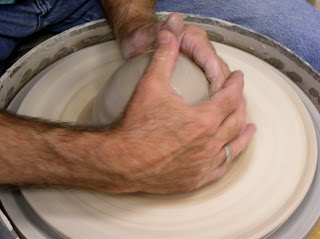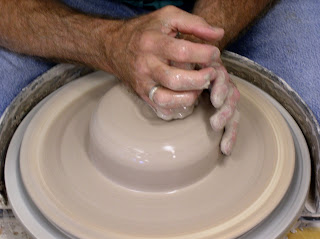Anyone new to throwing faces real challenges, an understatement to be sure. But a little appreciated aspect of pottery, or working with clay in general, is the initial and core relationship the ceramic artist or potter confronts with the material. Unlike most other three dimensional media, clay has no formal structure in the conventional sense. Potters and ceramic sculptors enjoy a greater array of possibilities, but also require much more than a cursory knowledge of our materials to produce a final work- let alone a good one.
All of the traditional and newer materials- metal, wood, plastics, rubber, stone, or found objects come with space filling and defining mass that holds itself together without and before external assistance (we'll skip "performance" work that sculptors somehow deemed themselves qualified to execute the last few decades- a curious conceit that requires a great deal of patience to talk about). When manipulating any of these materials, the maker starts with a structural surety that is then altered to the aesthetic need of the artist. With some exceptions the forming material itself is seldom "created." (Unless the artist is making his or her own steel from molten iron and coke! Indeed, I loved the Friday night "pours" of bronze or aluminum while in grad school at Syracuse University. And I remember spending more time in the glass blowing studio at Penland, one summer long ago, than in the clay shop! Glass blowers rock.)
I make this point to argue against the time honored and worn out hierarchy of artistic media (and with it, the art market) that dominates the art world. All three dimensional work requires a degree of skill (most often by the artist- this is another issue for a later time) to manipulate the material into some form and shape, or arrangement, true enough. But, clay simply exists in a form of mass only, with no clear direction or dimension. How is it that this trait leads to its lowly place, residing in the lower tiers of relevance and respect in the western art world (US)? Relatively few galleries can be found with clay artists an important part of the stable. It is not precious, being found literally everywhere, and the process is little understood by those looking at it. It is not pristine, thank god. It is only the stuff of life- in reality, not just as metaphor. So it is the most common of materials, yet requires the most uncommon mastery to achieve truly timeless results. Such is life.
Making works from clay requires the
simultaneous creation of structure, form and shape, and surface, especially making pots, to which you may add the acquired knowledge of functional design. As mentioned above, some media, techniques in metalsmithing come to mind, perform the same magic. Luckily, the jeweler, being in the much more marketable realm of fashion, enjoys greater popularity, a reflection of our cultural leanings. Clay works are certainly enjoying a popularity like never before. But, unlike a culture educated in and by the crafts in general, like Japan, handmade pots in our culture are not universally received into the home. This seems the case regardless of the very successful move toward fashion seen in much contemporary (American baroque?) work. Surface design manipulation is stronger than ever. But I think William Morris would be rolling in his grave.
A word of caution is needed. Fashion is just that. I like the ornamentation and decoration (confession: I wish I was better at it). Even in Japan highly decorated works easily coexist with the understated, thanks mainly to the local geopolitical dominance Japan once enjoyed. In our culture (and others to be fair), fashion (and sparkle) generally trumps utility and/or "risk taking," the core exercise of mentally reworking visual equations, that was drilled into our heads in art school. And, too often, sadly, fashion trumps art (to rework a favorite phrase from a colleague). As long as we understand the difference, all is forgiven. Commerce is a tough ruler, though.
It is naive to think the hierarchy will ever change. And, as mentioned above, there are certainly other factors in play. And many of my points can be added to or challenged (happily received!) But it is useful to know that our craft is indeed special. Much like the writer and the musician, we make something from nothing. Quite the feat!
A note is needed on media of another sort- the internet. As I have said many times in class, beware of what you see on the internet. "You Tube" is great but it seems anyone with an introductory course (or two?) under their belt thinks they have something to teach. This is endearing but many new potters should wait awhile before getting into the sharing mode. So many tired old wives tales are past along with no critical reflection. Teaching is an art form in itself and nothing makes the teacher better than experience, offline please.
Finally, magazines are a very good source of images and information. Here, too, a little discretion is helpful. As I learned early in my career, color (blue) sells. Editors want to sell magazines. Sometimes the visual flash of an image masks the quality (or lack therein) of the work. Anyone can now take quality images of their work and submit them for publication. But the work should be more than eye candy and slide craft.
I like the current movement to bring critical review to ceramics, but worry that it will just descend into the same lame push toward the "new" and the different which has resulted in so much bad work being done in the name of "Art." Just more politics with the reviewers holding sway.
So as you begin, note that nothing takes the place of an experienced teacher- still. Find teachers you trust. They will know what artists are worth looking at. Taking classes at an art school, my students come to know that we are teaching more than the mechanics of throwing. We want to meld craftsmanship with design, broad and deep bodies of knowledge, rich in history, loaded with excellent references to give you and your work context. Is it "art?" Time will tell. It is the process and the connections that are important. For now the goal is learning to throw. Then comes the important part- making pots. Enjoy the experience...
















